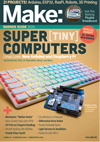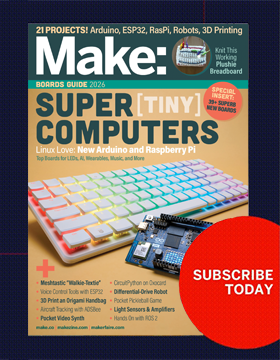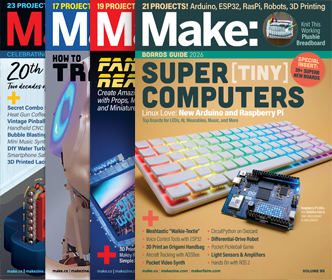
Rainbow Spectroscope
WHAT WILL YOU MAKE?
An optic device that splits light into different wavelengths. Produce and observe the light spectra!
WHAT WILL YOU LEARN?
You will learn to build a scientific device using a special spectroscope film — a diffraction grating. Then you will learn to view and decipher light spectra.
STEPS
STEP 1
Cut the Card stock
- Cut two squares of card stock that are large enough to cover the ends of the cardboard tube with space left over.
- If you do not have a cardboard tube, then use additional card stock to make a tube!
STEP 2
Add the Film
- Use the hole punch to punch a hole in the center of one of the squares of card stock. You might have to fold the edge of the square to get the hole punch over the center.
- Now tape a small piece of spectroscopic film over the hole that you punched. Do not get any tape over the hole!
STEP 3
Attach the Cardstock
- Place the card stock with the spectroscopic film over one end of the cardboard tube.
- Cut the card stock into a circular shape and then cut slits towards the center all the way around the card stock. Be careful not to cut too far! Only cut up to the tube-- do not make any cuts where the card stock stretches over the opening.
- Fold down the flaps that you made and tape the card stock to the tube by wrapping tape around the flaps.
STEP 4
Option A Spectroscrope
- Attach the other piece of card stock to the other end of the tube using the same process that you used in step 3.
- Use the thumbtack to poke a pattern into the card stock. Be creative with your pattern!
STEP 5
Option B Spectroscope
- Cut the remaining piece of card stock in half and center the two pieces over the end of the cardboard tube. Leave a couple millimeters of space between the halves.
- Before you tape the pieces down, look through the hole that you punched on the other end and turn the tube until the rainbows run parallel to the slit.
- After it is calibrated, tape the pieces down using the same method from step 3.
WHAT'S HAPPENING HERE?
Spectroscopy is the study of the spectra produced when material interacts with or emits light. A spectrograph — sometimes called a spectroscope or spectrometer — breaks the light from a single material into its component colors the way a prism splits white light into a rainbow. It records this spectrum, which allows scientists to analyze the light and discover properties of the material interacting with it. Spectroscopy is as crucial as imaging to understanding the universe. Learn more on NASA’s Hubblesite.
Materials:
- Spectroscope film (kit)
- Cardboard Tube
- Cardstock or construction paper
- Tape
- Scissors
- Thumbtack
- Hole Punch
See More Projects in these topics:
Arts & Crafts ScienceSee More Projects from these themes:
The Shop (Makerspace)Maker Camp
Please Note
Your safety is your own responsibility, including proper use of equipment and safety gear, and determining whether you have adequate skill and experience. Power tools, electricity, and other resources used for these projects are dangerous, unless used properly and with adequate precautions, including safety gear and adult supervision. Some illustrative photos do not depict safety precautions or equipment, in order to show the project steps more clearly. Use of the instructions and suggestions found in Maker Camp is at your own risk. Make Community, LLC, disclaims all responsibility for any resulting damage, injury, or expense.
Maker Camp Project Standards
Based on NGSS (Next Generation Science Standards)
National Core Arts Standards
The National Core Arts Standards are a process that guides educators in providing a unified quality arts education for students in Pre-K through high school. These standards provide goals for Dance, Media Arts, Music, Theatre, and Visual Arts with cross-cutting anchors in Creating, Performing, Responding, and Connecting through art. The Anchor Standards include:- Generate and conceptualize artistic ideas and work.
- Organize and develop artistic ideas and work.
- Refine and complete artistic work.
- Select, analyze, and interpret artistic work for presentation.
- Develop and refine artistic techniques and work for presentation.
- Convey meaning through the presentation of artistic work.
- Perceive and analyze artistic work.
- Interpret intent and meaning in artistic work.
- Apply criteria to evaluate artistic work.
- Synthesize and relate knowledge and personal experiences to make art.
- Relate artistic ideas and works with societal, cultural, and historical context to deepen understanding.
CCSS (Common Core State Standards)
The Common Core is a set of high-quality academic standards in mathematics and English language arts/literacy (ELA).English Language Arts Standards » Science & Technical Subjects
- Middle School
-
-
- CCSS.ELA-LITERACY.RST.6-8.1 Cite specific textual evidence to support analysis of science and technical texts.
- CCSS.ELA-LITERACY.RST.6-8.3 Follow precisely a multistep procedure when carrying out experiments, taking measurements, or performing technical tasks.
- CCSS.ELA-LITERACY.RST.6-8.4 Determine the meaning of symbols, key terms, and other domain-specific words and phrases as they are used in a specific scientific or technical context relevant to grades 6-8 texts and topics.
- CCSS.ELA-LITERACY.RST.6-8.5 Analyze the structure an author uses to organize a text, including how the major sections contribute to the whole and to an understanding of the topic.
- CCSS.ELA-LITERACY.RST.6-8.6 Analyze the author's purpose in providing an explanation, describing a procedure, or discussing an experiment in a text.
-
- High School
-
- CCSS.ELA-LITERACY.RST.9-10.1 Cite specific textual evidence to support analysis of science and technical texts, attending to the precise details of explanations or descriptions.
- CCSS.ELA-LITERACY.RST.9-10.3 Follow precisely a complex multistep procedure when carrying out experiments, taking measurements, or performing technical tasks, attending to special cases or exceptions defined in the text.
- CCSS.ELA-LITERACY.RST.9-10.4 Determine the meaning of symbols, key terms, and other domain-specific words and phrases as they are used in a specific scientific or technical context relevant to grades 9-10 texts and topics.
- CCSS.ELA-LITERACY.RST.9-10.5 Analyze the structure of the relationships among concepts in a text, including relationships among key terms (e.g., force, friction, reaction force, energy).
- CCSS.ELA-LITERACY.RST.9-10.6 Analyze the author's purpose in providing an explanation, describing a procedure, or discussing an experiment in a text, defining the question the author seeks to address.
- CCSS.ELA-LITERACY.RST.11-12.1 Cite specific textual evidence to support analysis of science and technical texts, attending to important distinctions the author makes and to any gaps or inconsistencies in the account.
- CCSS.ELA-LITERACY.RST.11-12.3 Follow precisely a complex multistep procedure when carrying out experiments, taking measurements, or performing technical tasks; analyze the specific results based on explanations in the text.
- CCSS.ELA-LITERACY.RST.11-12.4 Determine the meaning of symbols, key terms, and other domain-specific words and phrases as they are used in a specific scientific or technical context relevant to grades 11-12 texts and topics.
- CCSS.ELA-LITERACY.RST.11-12.5 Analyze how the text structures information or ideas into categories or hierarchies, demonstrating understanding of the information or ideas.
- CCSS.ELA-LITERACY.RST.11-12.6 Analyze the author's purpose in providing an explanation, describing a procedure, or discussing an experiment in a text, identifying important issues that remain unresolved.
NGSS 3-5.Engineering Design
The Next Generation Science Standards (NGSS) are K–12 science content standards.- 3-5-ETS1-1. Define a simple design problem reflecting a need or a want that includes specified criteria for success and constraints on materials, time, or cost.
- 3-5-ETS1-2. Generate and compare multiple possible solutions to a problem based on how well each is likely to meet the criteria and constraints of the problem.
- 3-5-ETS1-3. Plan and carry out fair tests in which variables are controlled and failure points are considered to identify aspects of a model or prototype that can be improved.
NGSS MS.Engineering Design
The Next Generation Science Standards (NGSS) are K–12 science content standards.- MS-ETS1-1. Define the criteria and constraints of a design problem with sufficient precision to ensure a successful solution, taking into account relevant scientific principles and potential impacts on people and the natural environment that may limit possible solutions.
- MS-ETS1-2. Evaluate competing design solutions using a systematic process to determine how well they meet the criteria and constraints of the problem.
- MS-ETS1-3. Analyze data from tests to determine similarities and differences among several design solutions to identify the best characteristics of each that can be combined into a new solution to better meet the criteria for success.
- MS-ETS1-4. Develop a model to generate data for iterative testing and modification of a proposed object, tool, or process such that an optimal design can be achieved.
NGSS HS.Engineering Design
The Next Generation Science Standards (NGSS) are K–12 science content standards.- HS-ETS1-1. Analyze a major global challenge to specify qualitative and quantitative criteria and constraints for solutions that account for societal needs and wants.
- HS-ETS1-2. Design a solution to a complex real-world problem by breaking it down into smaller, more manageable problems that can be solved through engineering.
- HS-ETS1-3. Evaluate a solution to a complex real-world problem based on prioritized criteria and trade-offs that account for a range of constraints, including cost, safety, reliability, and aesthetics as well as possible social, cultural, and environmental impacts.
- HS-ETS1-4. Use a computer simulation to model the impact of proposed solutions to a complex real-world problem with numerous criteria and constraints on interactions within and between systems relevant to the problem.
ALL DONE? SHARE IT!
Share pictures and videos of your cool build! Be sure to use #maketogether or #makercamp
POST YOUR PROJECTS


